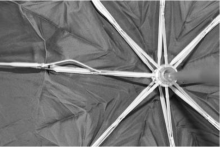If you would like to see more information on this case study, click here!
You can request this case study and a WCDE staff member will get back to you.
 As a fourth year mechanical engineering design project, Thomas Holbrook chose to take on an age-old problem and apply engineering analysis to design an umbrella that will not invert in the face of strong winds. Umbrella inversion is the tendency for the fabric canopy to blow inside out. When an umbrella inverts, the user gets wet, violating the primary function of the umbrella. An umbrella that failed due to a buckled rib component is shown in Figure 1. Inversion compromises the rigidity of the umbrella structure and after inversion the umbrella is prone to invert again because of the weakened structure. To mitigate inversion the umbrella is turned and pointed back into the wind to correct the issue and may cause additional buckling and failure of structural components. To ensure that the resulting umbrella would be a significant improvement over existing designs, he chose a target wind speed of 70 mph, or about 31 m/s. He also wanted an umbrella that was aesthetically pleasing, light weight, collapsible, and easy to manufacture.
As a fourth year mechanical engineering design project, Thomas Holbrook chose to take on an age-old problem and apply engineering analysis to design an umbrella that will not invert in the face of strong winds. Umbrella inversion is the tendency for the fabric canopy to blow inside out. When an umbrella inverts, the user gets wet, violating the primary function of the umbrella. An umbrella that failed due to a buckled rib component is shown in Figure 1. Inversion compromises the rigidity of the umbrella structure and after inversion the umbrella is prone to invert again because of the weakened structure. To mitigate inversion the umbrella is turned and pointed back into the wind to correct the issue and may cause additional buckling and failure of structural components. To ensure that the resulting umbrella would be a significant improvement over existing designs, he chose a target wind speed of 70 mph, or about 31 m/s. He also wanted an umbrella that was aesthetically pleasing, light weight, collapsible, and easy to manufacture.
The teaching objective of this case is to illustrate the engineering design process. The main expected learning outcome is for students to practice design synthesis. It is intended that the case study be open-ended, where students will need to move through the engineering design process, and conceptualize adequate solutions based on the design requirements. The case is applicable for ME 100 (Mechanical Engineering Communication and Professionalism), SYDE 161 (Introduction to Design), ME 321 (Kinematics and Dynamics of Machines), ME 380 (Mechanical Engineering Design Workshop), and SYDE 361 (Engineering Design).
If you would like to see more information on this case study, click here!
You can request this case study and a WCDE staff member will get back to you.
Contact Waterloo Cases in Design Engineering
Steve Lambert
Tel: (519) 888-4728
Email: steve@uwaterloo.ca
The University of Waterloo acknowledges that much of our work takes place on the traditional territory of the Neutral, Anishinaabeg and Haudenosaunee peoples. Our main campus is situated on the Haldimand Tract, the land granted to the Six Nations that includes six miles on each side of the Grand River. Our active work toward reconciliation takes place across our campuses through research, learning, teaching, and community building, and is co-ordinated within the Office of Indigenous Relations.